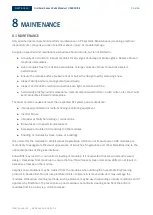
FIRST SOLAR
First Solar Series 6 CuRe Modules | USER GUIDE
18 of 26
FIRST SOLAR, INC. | MPD-00600-06-C REV 1.0
Figure 11: The above-ground DC cabling (typically a bundle of harnesses and PV array cables) may be supported by the
wire management holes located on the Series 6 CuRe module edge frames.
►
Holes located 265 mm (10.4 in) from the center of the edge frame:
o
Support DC wiring bundle on Single-Torque Tube Tracker Systems
o
Support Harness end/connector (as it is being routed to the junction box)
►
Holes located 700 mm (27.6in) from the center of the edge frame:
o
Support DC wiring bundle on Two-Girder Tracker and Fixed-Tilt Systems
o
Support DC wiring bundle on Single-Torque Tube Tracker Systems with moving components that
extend beyond 350 mm (13.8 in) from the center of the structure.
Typically, the lead wire connection does not require wire retention or securement due to the proximity of the
junction boxes on adjacent modules.
Above-ground DC cabling (typically a bundle of harness and homerun PV cables) may be supported by
utilizing the wire management holes located on the frame. The module frame includes four 5.6 mm (0.22
in) wire management holes in locations depicted in Figure 11. The maximum cable weight carried by each
module in totality may not exceed 3.5 kg (7.6 lbs). Do not use junction box for wire management
attachment.









































